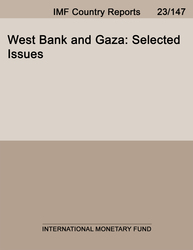
West Bank and Gaza: Selected Issues
West Bank and Gaza: Selected Issues
READ MORE...
Volume/Issue:
Volume 2023
Issue 147
Publication date: April 2023
ISBN: 9798400241161
$20.00
Add to Cart by clicking price of the language and format you'd like to purchase
Available Languages and Formats
| English |
Prices in red indicate formats that are not yet available but are forthcoming.
Topics covered in this book
This title contains information about the following subjects.
Click on a subject if you would like to see other titles with the same subjects.
Labor , Money and Monetary Policy , International - Economics , A , labor market outcome , labor productivity growth , labor market outcome , PA policy , growth-employment nexus , Labor markets , Women , Employment , Labor force , Job creation
Also of interest
Summary
Over the last two decades, the Palestinian economy did not create enough jobs to absorb new labor market entrants. This even as labor force participation rates remained stubbornly low and among the lowest in the world for Palestinian women. Female labor outcomes are particularly disappointing. For both sexes, there are high disparities in labor market outcomes across governorates and cities, reflecting geographic fragmentation and spatial mismatch between labor force and employment growth. Moreover, the gap in labor outcomes between the West Bank and Gaza has widened over time. Further facilitation of private sector job creation in high-productivity tradable services sectors could help absorb well-educated labor market entrants, while Palestinian Authority (PA) policies could raise female labor force participation and employment. But PA policies alone will not suffice to tackle job market challenges, as growth remains tepid in ambitious policy scenarios, barring easing of Israeli-imposed restrictions on the movement of people. Overall, a high elasticity of jobs to growth of 0.7 suggests improved labor market outcomes and higher growth would go hand in hand.
Copyright © 2010 - 2025
Powered by:
AIDC



